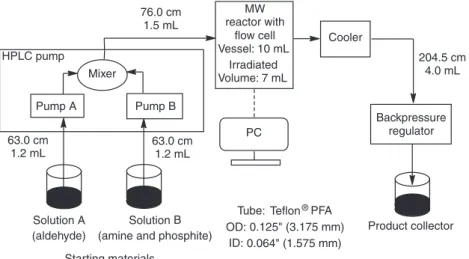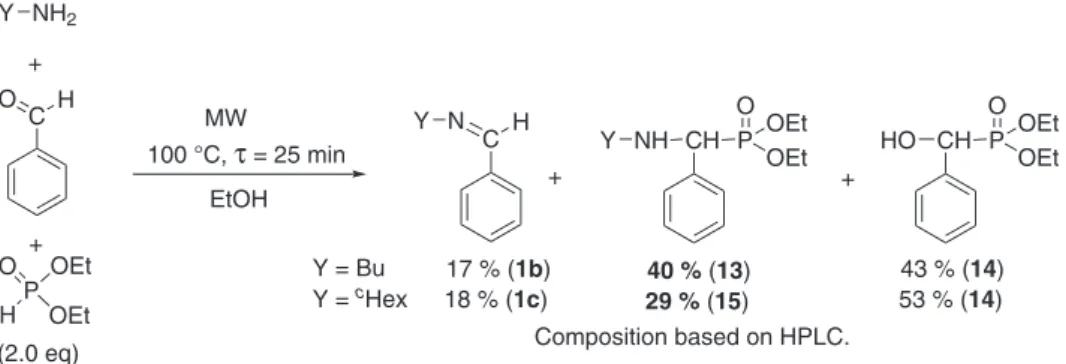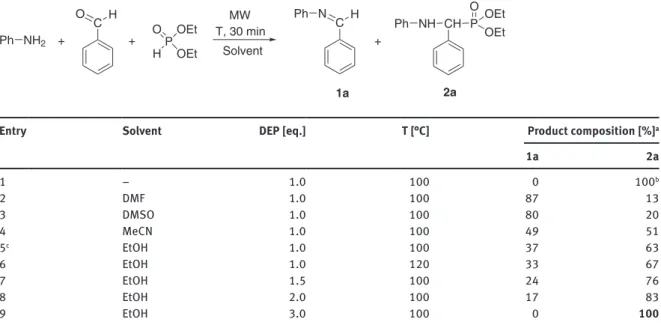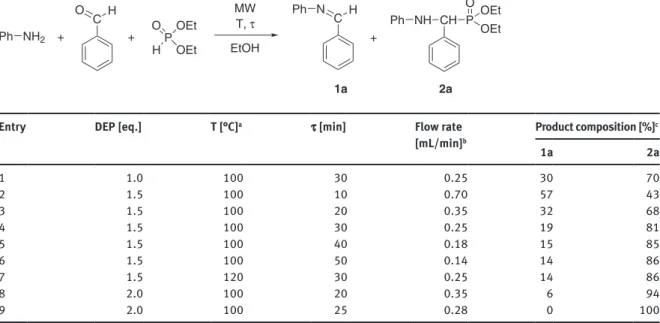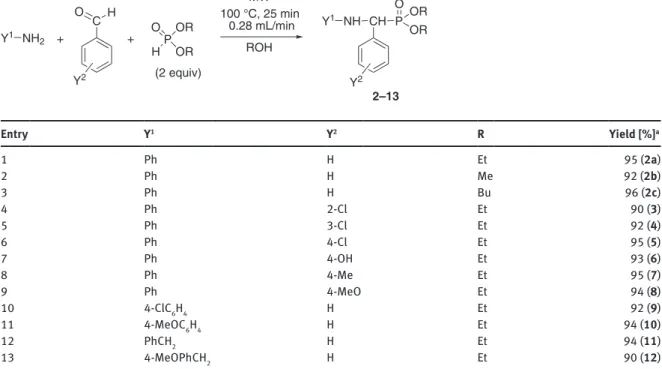Conference paper
Erika Bálint*, Ádám Tajti, Katalin Ladányi-Pára, Nóra Tóth, Béla Mátravölgyi and György Keglevich*
Continuous flow synthesis of α -aryl- α -aminophosphonates
https://doi.org/10.1515/pac-2018-0923
Abstract: The synthesis of α-aryl-α-aminophosphonates was performed by the three-component Kabachnik- Fields reaction of primary amines, benzaldehyde derivatives and dialkyl phosphites in a continuous flow microwave reactor. The target compounds could be obtained in high (~90 %) yields without any catalyst in simple alcohols as the solvent. The flow process elaborated required shorter reaction times and lower excess of the reagent, as compared to the “traditional” batch reactions, and allowed the synthesis of the α-aminophosphonates on a somewhat larger scale.
Keywords: α-aminophosphonates; continuous flow reactor; ICPC-22; Kabachnik-Fields reaction; microwave;
Pudovik reaction.
Introduction
In the past few years, flow reactors have started to become common in modern laboratories [1]. Their advan- tages, such as the more efficient control of reaction conditions, the easier real time analytics and the safer handling of hazardous reactions slowly convince the academic and industrial community [2]. Moreover, the flow reactions may be significantly better in productivity, selectivity and yields, as compared to batch approaches [3].
In microwave (MW) chemistry, due to the limited geometry of the MW devices, the scale-up of reactions is a real challenge [4]. By the use of flow chemistry, this problem can be eliminated [5]. During the last decade, several applications of continuous flow MW reactors were reported, however, due to the many non-profes- sional MW reactors (“fabricated” from MW ovens), the reproduction of these approaches is problematic [6].
α-Aminophosphonates are the structural P-analogs of natural α-amino acids. Due to this similarity, they have potential biological activity [7]. The Kabachnik-Fields condensation (I) and the aza-Pudovik reaction (II) are the two main synthetic routes to α-aminophosphonate derivatives (Scheme 1) [8]. In the Kabachnik-Fields reaction, three components, an amine, an oxo compound and a >P(O)H reagent react in a one-pot manner [9], while in the aza-Pudovik reaction, a >P(O)H reagent is added to the C=N double bond of an imine [10].
Although several exotic catalytic systems have been reported, in most cases, there is no need for any catalysts and/or solvents under MW irradiation [11]. Moreover, under MW conditions, the reactions become faster and
Article note: A collection of invited papers based on presentations at the 22nd International Conference on Phosphorous Chemistry (ICPC-22) held in Budapest, Hungary, 8–13 July 2018.
*Corresponding authors: Erika Bálint and György Keglevich, Department of Organic Chemistry and Technology, Budapest Uni- versity of Technology and Economics, Budapest 1521, Hungary, e-mail: ebalint@mail.bme.hu (E. Bálint);
gkeglevich@mail.bme.hu (G. Keglevich)
Ádám Tajti, Katalin Ladányi-Pára, Nóra Tóth and Béla Mátravölgyi: Department of Organic Chemistry and Technology, Budapest University of Technology and Economics, Budapest 1521, Hungary
more efficient [12]. A good possibility for the scale-up of the synthesis of α-aminophosphonates is to use a flow MW reactor instead of the batch equipment [13].
In the literature, there are two publications dealing with the continuous preparation of α-aminophoshonates, however, in these procedures, the aza-Pudovik approach (II) was applied.
Stevens and co-workers investigated the aza-Pudovik reaction of α-aliphatic and α-aromatic imines with dimethyl phosphite in a microreactor (Scheme 2) [14]. In the first stage, the reaction conditions were optimized in a batch reactor, and then the best set of conditions was transferred to the flow system. The α-aminophosphonates were obtained in yields of 68–82 % after a relatively long (78 min) residence time.
Britton investigated the synthesis of diethyl (phenylamino)benzylposphonate in a special thin-film vortex fluidic device (VFD) (Scheme 3) [15]. In the first instance (a), the traditional aza-Pudovik reaction of N- benzylideneaniline and diethyl phosphite was elaborated using iodine as the catalyst and DMF as the solvent in one device. As a continuation, an imine formation in methanol followed by an iodine- catalyzed Pudovik reaction in DMF was carried out in one system (b). The authors claimed in a later review that the two-step reaction allowed a more efficient product formation as compared to the three-component accomplishment [16].
The continuous flow synthesis of α-aminophosphonates by the one-pot Kabachnik-Fields condensation (I) was mentioned only in a PhD dissertation in the group of Stevens [17]. The three-component reaction of iso- propylamine, benzaldehyde and dialkyl phosphites in an alcohol as the solvent was studied in a microreactor (Scheme 4). The purpose of adding one equivalent of trialkyl orthoformate to the mixture was to eliminate the water formed in the reaction. Although several different circumstances were tried out, a significant amount of α-hydroxyphosphonate was also formed beside the expected α-aminophosphonate. According to the author,
+ OP H
OMe
OMe CH
R2 P O
OMe C
R2
N H
R1
68–82 % 50 °C, 78 min
R1 = iPr, Bn, allyl
R2 = iPr, cHex, 2-Ph-ethenyl, Ph, 2-furyl
R1 NH OMe
(2 equiv)
MeOH
Scheme 2: Aza-Pudovik reaction of imines with dimethyl phosphite in a microreactor.
CH
80 % I2 (20 %)
DMF 50 °C, 6 min
MeOH O
+
NH2 N C H
50 °C, 7.4 min
OP H
OEt
OEt (2 equiv) HN P O OEt
OEt
b a
Scheme 3: Synthesis of diethyl (phenylamino)benzylposphonate by aza-Pudovik reaction.
HN C Y1 Y2
PO Z1 Z2 R
R NH2 C Y1 Y2 + +
- H2O O
C
N OP
H Z1 Z1 R +
Y2 Y1
I.
II.
OP H
Z1 Z1
Scheme 1: Procedures for the synthesis of α-aminophoshonates.
the three-component synthesis was not efficient due to the low conversion and the poor selectivity towards the α-aminophosphonates.
In the field of continuous flow multicomponent reactions, it is known that selectivity problems may occur [18]. Similar problems were reported in different multicomponent reactions, such as cyclizations, con- densations and also the regular Mannich reactions, which may be solved by reducing the number of the components [19].
In this paper, we aimed at developing a MW-assisted continuous flow method for the synthesis of α-aryl- α-aminophosphonates by the three-component Kabachnik-Fields reaction of primary amines, aldehydes and dialkyl phosphites. Our purpose was to find the optimum conditions for the selective formation of the α-aminophosphonates in a flow MW reactor, and to elaborate the MW-assisted synthesis of the title com- pounds on a bigger scale.
Experimental
General
HPLC-MS experiments were performed with an Agilent 1200 liquid chromatography system coupled with a 6130 quadrupole mass spectrometer equipped with an ESI ion source (Agilent Technologies, Palo Alto, CA, USA). Analysis was performed at 40 °C on a Gemini C18 column (150 mm × 4.6 mm, 3 ƒμm; Phenomenex, Torrance, CA, USA) with a mobile phase flow rate of 0.6 mL/min. Composition of eluent A was 0.1 % NH4HCO3 in water; eluent B was 0.1 % HCO2NH4 and 8 % water in acetonitrile. 0→3 min 5 % B, 3→13 min gradient, 13→20 min 95 % B. The injection volume was 5 μL. The chromatographic profile was registered at 222 nm. The MSD operating parameters were as follows: positive ionization mode, scan spectra from m/z 100 to 1000, drying gas temperature 300 °C, nitrogen flow rate 12 L/min, nebulizer pressure 60 psi, capil- lary voltage 2500 V.
High resolution mass spectrometric measurements were performed using a TripleTOF 5600 + mass spec- trometer in positive electrospray mode.
The 31P NMR spectra were obtained on a Bruker AV-300 spectrometer at 121.5 MHz. Chemical shifts are downfield relative to 85 % H3PO4.
Equipment
The continuous flow reactions were performed in a self-developed continuous flow system comprising a 300 W CEM Discover focused microwave reactor equipped with a CEM 10 mL Flow Cell Accessory continuous flow unit (irradiated volume 7 mL) [20, 21], a Gilson 332 dual HPLC pump, an HPLC backpressure regulator with a 250 psi (17.2 bar) cartridge, and a cooler. The temperature was monitored and controlled by IR sensor, which is located below the MW cavity floor and measures the temperature on the bottom of the vessel. Teflon® PFA tubes with outside diameter: 0.125″ (3.175 mm), and inside diameter 0.064″ (1.575 mm) were used. The
CH
48–49 % 50–70 °C, 78–118 min
O
iPrNH2 + OP
H OR OR
iPrNH P
O OR OR
+ ROH
HC(OR)3 (1 equiv)
(2 equiv) R = Me, Et
HO CH P O OR
OR +
Scheme 4: Attempts to synthesize α-aminophosphonates by Kabachnik-Fields reaction.
exact lengths and volumes of each tube parts are shown in Fig. 1. All of the tubes, nuts and ferrules applied were fully compatible with a regular HPLC system.
General procedure for the batch synthesis of α -aryl- α -aminophosphonates by Kabachnik-Fields reaction
A mixture of 1.0 mmol of aniline (0.09 mL), 1.0 mmol of benzaldehyde (0.10 mL) and diethyl phosphite (1.0 mmol [0.13 mL], 1.5 mmol [0.19 mL], 2.0 mmol [0.26 mL] or 3.0 mmol [0.39 mL]) in 2 mL of a solvent (DMF, DMSO, MeCN or EtOH) was irradiated in a sealed tube at 100–120 °C for 30 min in a CEM Microwave reactor equipped with a pressure controller. The volatile components were removed under reduced pressure, and the residue obtained was analyzed by HPLC.
General procedure for the continuous flow synthesis of α -aryl- α -aminophosphonates by Kabachnik-Fields reaction
Before each experiment, two solutions (A and B) were prepared. For solution A, 35.0 mmol of the ben- zaldehyde derivatives (benzaldehyde [3.6 mL], 2-chlorobenzaldehyde [3.9 mL], 3-chlorobenzaldehyde [4.0 mL], 4-chlorobenzaldehyde [4.9 g], 4-hydroxybenzaldehyde [3.5 mL], 4-methylbenzaldehyde [4.1 mL]
or 4- methoxybenzaldehyde [4.3 mL]) were dissolved in alcohols (methanol, ethanol or butanol) in a 50 mL volumetric flask, resulting in the aldehyde concentration of 0.70 M. For solution B, 35.0 mmol of the amines (aniline [3.2 mL], 4-chloroaniline [4.6 g], 4-methoxyaniline [4.3 g], benzylamine [3.8 mL], 4-methoxyben- zylamine [4.6 mL], butylamine [3.5 mL] or cyclohexylamine [4.0 mL]) and dialkyl phosphites [35.0 mmol of diethyl phosphite (4.5 mL) or 52.5 mmol of diethyl phosphite (6.8 mL), or 70.0 mmol of dimethyl phosphite (6.4 mL), diethyl phosphite (9.0 mL) or dibutyl phosphite (13.7 mL)] were dissolved in alcohols (methanol, ethanol or butanol) in a 50 mL volumetric flask, resulting in the amine concentration of 0.70 M and the dialkyl phosphite concentration of 0.70 M, 1.05 M or 1.40 M, respectively. The two solutions (A and B) were pumped separately. The system was flushed with 15 mL of solution A and 15 mL of solution B with a summa flow rate of 10 mL/min (A:B 1:1) at 25 °C and 17 bar. Next, under the same pressure, the flow rate was set to the desired value (can be seen in Tables 3, 4 and Scheme 5) and the vessel was irradiated with a power of 20–100 W for 3–5 min, until the temperature reached the desired value, then the power was controlled automatically by the software of the MW reactor. The operation was regarded steady state on the basis of the results of the HPLC measurements. The α-aminophosphonates were obtained by column chromatography using silica gel
Product collector MW
reactor with
flow cell Cooler
Solution A (aldehyde)
Starting materials
Backpressure regulator Pump A
Mixer HPLC pump
Pump B 63.0 cm PC
1.2 mL
76.0 cm 1.5 mL
204.5 cm 4.0 mL Vessel: 10 mL
Irradiated Volume: 7 mL
Tube: Teflon® PFA OD: 0.125" (3.175 mm)
ID: 0.064" (1.575 mm) Solution B
(amine and phosphite) 63.0 cm
1.2 mL
Fig. 1: Design parameters of the continuous flow system.
as the absorbent and ethyl acetate:hexane (1:1) or dichloromethane:methanol (97:3) as the eluent. Yields were calculated on the basis of the mass obtained after separation and evaporation taking into consideration the quantity of the limiting starting materials fed in during a given time.
General procedure for the continuous flow synthesis of α -aryl- α -aminophosphonates by Pudovik reaction
The continuous flow Pudovik reactions were carried out in the same system using a Gilson 305 single HPLC pump. The mixture of 25.0 mmol of the imines (synthesized by a previously reported method [10]) (1b [4.0 g]
or 1c [4.7 g]) and diethyl phosphite (50 mmol [6.4 mL], 62.5 mmol [8.1 mL] or 75 mmol [9.7 mL]) was dissolved in 50 mL ethanol. The reactor was flushed with 20 mL of the mixture with a flow rate of 10 mL/min at 25 °C and 17 bar. Next, under the same pressure, the flow rate was set to the desired value (can be seen in Table 5), and the vessel was irradiated with a power of 25–50 W for 3–5 min, until the temperature reached the desired value, then the power was controlled automatically by the software of the MW reactor. The operation was
CH P Y
C O O
+ OPOEt
OEt H
H Y NH2
+
NH OEt
100 °C, τ = 25 min OEt EtOH
(2.0 eq)
17 % (1b)
CH P O
HO OEt
+ OEt
Composition based on HPLC.
Y = Bu
Y = cHex 18 % (1c) N C
Y H
+
40 % (13) 29 % (15)
43 % (14) 53 % (14) MW
Scheme 5: Continuous flow MW-assisted Kabachnik-Fields reaction of butylamine and cyclohexylamine with benzaldehyde and diethyl phosphite.
Table 1: 31P NMR and HRMS Data for the α-aryl-α-aminophosphonates.
Compound δP in CDCl3 δP [lit.] in CDCl3 [M + H] + found [M + H] + requires
1a – – 182.0972 182.0964
1b – – 162.1282 162.1277
1c – – 188.1441 188.1434
2a 22.8 22.8 [10] 320.1418 320.1410
2b 25.2 25.2 [10] 292.1103 292.1097
2c 22.7 22.7 [10] 376.2044 376.2036
3 20.2 20.0 [22] 354.1033 354.1026
4 20.4 20.2 [23] 354.1034 354.1026
5 22.1 22.5 [24] 354.1033 354.1026
6 21.0 21.3 [25] 336.1373 336.1365
7 20.0 19.9 [25] 334.1577 334.1572
8 22.7 22.4 [26] 350.1528 350.1521
9 20.9 20.8 [26] 354.1024 354.1016
10 21.4 21.3 [22] 350.1529 350.1521
11 23.6 23.5 [27] 334.1579 334.1572
12 23.7 23.5 [28] 364.1686 364.1678
13 23.8 23.8 [10] 300.1734 300.1723
14 21.6 21.5 [29] 245.0940 245.0937
15 24.1 24.1 [10] 326.1890 326.1880
regarded steady state on the basis of the results of the HPLC measurements. The α-aminophosphonates were obtained by column chromatography using silica gel as the absorbent and ethyl acetate:hexane 1:1 as the eluent. Yields were calculated on the basis of the mass obtained after separation and evaporation taking into consideration the quantity of the starting materials fed in during a given time.
The measured and literature [10, 22–29] 31P NMR data of the α-aryl-α-aminophosphonates, as well as the HRMS data are listed in Table 1.
Results and discussion
The first model investigated was the Kabachnik-Fields reaction of aniline with benzaldehyde and diethyl phosphite (DEP) in a batch MW reactor (Table 2). It was previously reported by our research group that in the absence of any catalyst and solvent, the condensation reached full conversion using one equivalent of DEP at 100 °C for 30 min (Table 2/Entry 1). As the solvent-free condition is not flow compatible, it was necessary to find a suitable solvent to avoid heterogeneity and/or high viscosity in the reaction mixture. Therefore, the condensation was studied using various solvents, such as DMF, DMSO, acetonitrile, as well as ethanol at 100 °C for 30 min (Table 2/Entries 2–5). Carrying out the reaction in DMF and in DMSO, the product com- position was almost similar, however, only 13 % and 20 % of the target α-aryl-α-aminophosphonate (2a) was present beside the imine (1a) formed in the condensation of the aniline and the benzaldehyde (Table 2/
Entries 2 and 3). Applying acetonitrile, the ratio of compound 2a increased to 51 % (Table 2/Entry 4). Among the solvents investigated, ethanol proved to be the most efficient, since the α-aminophosphonate (2a) could be prepared in the proportion of 63 % (Table 2/Entry 5). In order to find the optimum conditions for the forma- tion of diethyl ((phenylamino)(phenyl)methyl)phosphonate (2a) in ethanol, the condensation was performed applying a longer reaction time, higher temperature or using the phosphite in a larger excess (Table 2/Entries 5–9). It was found that using one equivalent of the DEP, the product composition did not change signifi- cantly even after longer reaction time (40 min) or carrying out the synthesis at a higher temperature (120 °C) (Table 2/Entries 5 and 6). Applying a higher excess of the DEP (1.5 equiv) at 100 °C, the ratio of product 2a
Table 2: Kabachnik-Fields reaction of aniline with benzaldehyde and diethyl phosphite in a batch MW reactor.
Ph NH2 +
O C
+
H Ph CH P
O T, 30 min
MW NH
OEt OEt
1a OPOEt
OEt + H
N C
Ph H
Solvent
2a
Entry Solvent DEP [eq.] T [°C] Product composition [%]a
1a 2a
1 – 1.0 100 0 100b
2 DMF 1.0 100 87 13
3 DMSO 1.0 100 80 20
4 MeCN 1.0 100 49 51
5c EtOH 1.0 100 37 63
6 EtOH 1.0 120 33 67
7 EtOH 1.5 100 24 76
8 EtOH 2.0 100 17 83
9 EtOH 3.0 100 0 100
aDetermined by HPLC analysis. bBased on reference [10]. cNo change on longer reaction time. The bold number refers to the best composition of compound 2a in the reaction investigated in solvent.
was already 76 % (Table 2/Entry 7). Further increasing the excess of the DEP to two and three equivalents, the product ratios were 83 and 100 %, respectively (Table 2/Entries 8 and 9).
In the next step, the catalyst-free three-component reaction of aniline, benzaldehyde and DEP was investigated in a CEM MW reactor equipped with a commercially available CEM continuous flow cell.
Among the starting materials, the benzaldehyde reacts with aniline and also with DEP forming imine or α-hydroxyphosphonate, respectively, while there is no reaction between aniline and DEP at room tempera- ture, therefore, we developed a dual pump continuous flow system (Fig. 1). The benzaldehyde in ethanol (solution A) and the mixture of aniline and DEP in ethanol (solution B) was fed separately into the mixer. The mixture reached the reactor at a summa flow rate of 0.14–0.70 mL/min (corresponding to residence time of 50–10 min, respectively). The temperature was monitored and controlled by the IR sensor of the MW device.
The mixture leaving the reactor was cooled down using a spiral-like cooler (to 25 °C), and was passed through a back pressure regulator operating at 250 psi (17 bar). Consecutive fractions of the leaving mixture were analyzed by HPLC measurements in order to determine the composition and to identify the stationary operation.
The reaction conditions and the experimental results are shown in Table 3. To find the optimum con- ditions for the formation of the α-aryl-α-aminophosphonate (2a), the reaction was performed varying the excess of the DEP, the residence time and the reaction temperature. Carrying out the condensation with one equivalent of DEP at 100 °C with a residence time of 30 min (at a flow rate of 0.25 mL/min) the leaving mixture contained 30 % of the imine 1a and 70 % of the aminophosphonate 2a (Table 3/Entry 1). Using higher excess of the DEP (1.5 equivalents) and performing the reaction at 100 °C with a residence time of 10 min (at a flow rate of 0.70 mL/min), 57 % of compound 1a and 43 % of product 2a was formed (Table 3/Entry 2). Increasing the residence time to 20 or 30 min (by decreasing the flow rate to 0.35 or 0.25 mL/min), the ratio of α-aryl-α- aminophosphonate (2a) could be increased to 68 % or 81 %, respectively (Table 3/Entries 3 and 4). Applying a longer residence time of 40 or 50 min (by setting the flow rate of 0.18 or 0.14 mL/min), the composition did not change significantly (Table 3/Entries 5 and 6). The condensation was also carried out at 120 °C with a residence time of 30 min (at a flow rate of 0.25 mL/min), and the ratio of α-aryl-α-aminophosphonate (2a) was only 5 % higher than in the same experiment at 100 °C (Table 3/Entries 4 and 7). Thereafter, the effect of the increase of the excess of phosphite was studied. Using two equivalents of DEP at 100 °C at a flow rate of
Table 3: Optimization of the continuous flow MW-assisted Kabachnik-Fields reaction of aniline with benzaldehyde and diethyl phosphite.
Ph NH2
O C
+ H
OPOEt OEt
+ H MWT, τ
EtOH +
CH P Ph
O
NH OEt
OEt
1a N C
Ph H
2a
Entry DEP [eq.] T [°C]a τ [min] Flow rate
[mL/min]b Product composition [%]c
1a 2a
1 1.0 100 30 0.25 30 70
2 1.5 100 10 0.70 57 43
3 1.5 100 20 0.35 32 68
4 1.5 100 30 0.25 19 81
5 1.5 100 40 0.18 15 85
6 1.5 100 50 0.14 14 86
7 1.5 120 30 0.25 14 86
8 2.0 100 20 0.35 6 94
9 2.0 100 25 0.28 0 100
aThe pressure was 17 bar. bBased on the HPLC pump. cDetermined by HPLC analysis in the stationary operation.
0.35 mL/min (at a residence time of 20 min), the proportion of compound 2a was already over 90 % (Table 3/
Entry 8). Using a slightly longer residence time (25 min; by decreasing the flow rate to 0.28 mL/min), the reac- tion was complete (Table 3/Entry 9).
Based on the optimized conditions, the continuous flow Kabachnik-Fields reaction was extended to differ- ent amines, aldehydes and dialkyl phosphites (Table 4). The condensations were performed with two equiva- lents of the dialkyl phosphite at 100 °C using a flow rate of 0.28 mL/min (corresponding to a residence time of 25 min). After purification of the reaction mixture obtained in the experiment of Table 3/Entry 9, the diethyl ((phenylamino)(phenyl)methyl)-phosphonate (2a) was isolated in a yield of 95 % (Table 4/Entry 1). The con- densation of aniline and benzaldehyde was also carried out with dimethyl phosphite in methanol, as well as with dibutyl phosphite in butanol, and the corresponding α-aryl-α-aminophosphonates (2b and 2c) were obtained in a yield of 92 % and 96 %, respectively (Table 4/Entries 2 and 3). Thereafter, the three-component reaction of aniline and benzylamine derivatives was investigated with various substituted benzaldehydes (2-, 3- or 4-chlorobenzaldehyde, 4-hydroxybenzaldehyde 4-methylbenzaldehyde and 4- methoxybenzaldehyde) and DEP in ethanol. Altogether ten α-aryl-α-aminophosphonates (3–12) were obtained in high yields (90–
95 %) (Table 4/Entries 4–13).
Finally, the continuous flow MW-assisted Kabachnik-Fields reaction of butylamine and cyclohexylamine was investigated with benzaldehyde and DEP in ethanol under the optimized conditions (two equivalents of the DEP, 100 °C, τ = 25 min, at a flow rate of 28 mL/min) (Scheme 5). It was found that the condensation was not selective; beside the expected α-aryl-α-aminophosphonates (13 or 15), N-benzylideneamines (1b or 1c) and diethyl (hydroxy(phenyl)methyl)-phosphonate (14) were also formed. Based on the HPLC analysis, the proportion of product 13 or 15 was 40 % or 29 %, respectively. Neither a longer reaction time, nor a higher temperature changed significantly the ratio of the desired α-aryl-α-aminophosphonates (13 or 15), as a sig- nificant amount of the α-hydroxyphosphonate (14) was present in the reactions. Our observations in the flow Kabachnik-Fields condensation of butlyamine and cyclohexylamine were consistent with the results obtained in the similar reaction of isopropylamine [17].
Table 4: Continuous flow MW-assisted Kabachnik-Fields reaction of primary amines with benzaldehyde derivatives and dialkyl phosphites.
Y1 NH2
O C
+ H
OPOR OR + H
CH P Y1
O
NH OR
OR
Y2 2–13 Y2
100 °C, 25 min 0.28 mL/min
MW
ROH (2 equiv)
Entry Y1 Y2 R Yield [%]a
1 Ph H Et 95 (2a)
2 Ph H Me 92 (2b)
3 Ph H Bu 96 (2c)
4 Ph 2-Cl Et 90 (3)
5 Ph 3-Cl Et 92 (4)
6 Ph 4-Cl Et 95 (5)
7 Ph 4-OH Et 93 (6)
8 Ph 4-Me Et 95 (7)
9 Ph 4-MeO Et 94 (8)
10 4-ClC6H4 H Et 92 (9)
11 4-MeOC6H4 H Et 94 (10)
12 PhCH2 H Et 94 (11)
13 4-MeOPhCH2 H Et 90 (12)
aIsolated yield. Bold numbers refer to the corresponding products.
In order to avoid the formation of the unreactive α-hydroxyphosphonate 14 and to synthesize the α-aryl-α-aminophosphonates (13 and 15) selectively, we changed for the aza-Pudovik reaction of N-ben- zylidenebutylamine (1b) and N-benzylidenecyclohexylamine (1c) with DEP in ethanol in a continuous flow MW reactor (Table 5). First, the imine 1b was reacted with two equivalents of the DEP at 100 °C using a resi- dence time of 20 min (at a flow rate of 0.35 mL/min), and product 13 was formed with a conversion of only 52 % (Table 5/Entry 1). Increasing the excess of the DEP to 2.5 equivalents, the conversion was 26 % higher (78 %) (Table 5/Entry 2). Performing the addition with longer residence time, such as 30 or 40 min (flow rates of 0.25 or 0.18 mL/min), the conversions were similar, and 90 % of the α-aryl-α-aminophosphonate (13) was formed (Table 5/Entries 3 and 4). For a complete conversion, the use of three equivalents of the DEP was necessary at a flow rate of 0.25 mL/min (residence time of 30 min) (Table 5/Entry 5). From the mixture obtained, the diethyl ((butylamino)(phenyl)methyl)phosphonate (13) could be isolated in a yield of 90 % after purification. The aza-Pudovik reaction of N-benzylidenecyclohexylamine (1c) was carried out under similar conditions, and the corresponding α-aminophosphonate (15) was obtained in a yield of 92 % (Table 5/Entry 6).
Conclusions
In conclusion, an efficient, catalyst-free MW-assisted continuous flow method was elaborated for the selec- tive synthesis of various α-aryl-α-aminophosphonates with a somewhat higher productivity (1.7–2.2 g/h) as compared to the batch reactions. After the optimization of the reaction parameters, the continuous protocol was proved to be more effective; the corresponding α-aryl-α-aminophosphonates could be obtained using a lesser excess of DEP and in a shorter reaction time. The three-component Kabachnik-Fields reaction in a flow MW reactor is a novel approach for the preparation of the target compounds.
Acknowledgements: The project was supported by the Hungarian Research Development and Innovation Fund (FK123961 and K119202), by the National Research, Development and Innovation Fund of Hungary in the frame of the FIEK_16-1-2016-0007 (Higher Education and Industrial Cooperation Center) project and by the János Bolyai Research Scholarship of the Hungarian Academy of Sciences (BO/00278/17/7) (E.B.), as well as by the ÚNKP-18-4-BME-131 New National Excellence Program of the Ministry of Human Capacities (E.B.).
Table 5: Continuous flow MW-assisted aza-Pudovik reaction of N-benzylideneamines with DEP.
N C Y
+
H Y CH P
O 100 °C, MW τ NH OEt
OEt
1
Y = Bu (b), cHex (c)
Y = Bu (13), cHex (15) OPOEt
OEt
H EtOH
Entry Y DEP [eq.] τ [min] Flow rate [mL/min]a Conversion [%]b Yield [%]c
1 Bu 2.0 20 0.35 52 –
2 Bu 2.5 20 0.35 78 –
3 Bu 2.5 30 0.25 89 –
4 Bu 2.5 40 0.18 90 –
5 Bu 3.0 30 0.25 100 90 (13)
6 cHex 3.0 30 0.25 100 92 (15)
aBased on the HPLC pump. bDetermined by HPLC analysis in the stationary operation. cIsolated yield. Bold numbers refer to the corresponding products.
References
[1] T. Glasnov. Continuous-Flow Chemistry in the Research Laboratory, Springer, Switzerland (2016).
[2] D. T. McQuade, P. H. Seeberger. J. Org. Chem. 78, 6384 (2013).
[3] Sustainable Flow Chemistry: Methods and Applications, L. Vaccaro (Ed.), Wiley-VCH, Weinheim (2017).
[4] E. Bálint, G. Keglevich. In Milestones in Microwave Chemistry – SpringerBriefs in Molecular Science, G. Keglevich (Ed.), pp.
1–10, Springer, Switzerland (2016).
[5] Microwaves in Organic Synthesis, A. de la Hoz, A. Loupy (Eds.), Wiley-VCH: Weinheim (2012).
[6] L. Estela, M. Pouxb, N. Benamaraa, I. Polaerta. Chem. Eng. Process. 113, 56 (2016).
[7] Aminophosphonic and Aminophosphinic acids: Chemistry and Biological Activity, V. P. Kukhar, H. R. Hudson (Eds.) Wiley- VCH, Chichester (2000).
[8] E. Bálint, Á. Tajti, A. Tripolszky. In Organophosphorus Chemistry – Novel Developments, G. Keglevich (Ed.), pp. 108–147, De Gruyter, Berlin (2018).
[9] G. Keglevich, E. Bálint. Molecules 17, 12821 (2012).
[10] E. Bálint, Á. Tajti, A. Ádám, I. Csontos, K. Karaghiosoff, M. Czugler, P. Ábrányi-Balogh, G. Keglevich. Beilstein J. Org. Chem.
13, 76 (2017).
[11] G. Keglevich, A. Szekrényi. Lett. Org. Chem. 5, 616 (2008).
[12] J. D, Moseley. In Microwave Heating as a Tool for Sustainable Chemistry, N. Leadbeater, (Ed.), pp. 105–147, CRC Press, New York (2010).
[13] I. Baxendale, J. Hayward, S. Ley. Comb. Chem. High T. Scr. 10, 802 (2007).
[14] E. Van Meenen, K. Moonen, D. Acke, C. V. Stevens. Arkivoc (i), 31 (2006).
[15] J. Britton, J. W. Castle, G. A. Weiss, C. L. Raston. Chem. Eur. J. 22, 10773 (2016).
[16] J. Britton, C. L. Raston. Chem. Soc. Rev. 46, 1250 (2017).
[17] D. Acke. Evaluation of Microreactor Technology for Multicomponent Reactions, Ghent University, Belgium (2007).
[18] S. Van Mileghem, C. Veryser, W. M. De Borggraeve, in Flow Chemistry for the Synthesis of Heterocycles, U. K. Sharma, E. V.
Van der Eycken (Eds.), pp. 133–159, Springer, Heidelberg (2018).
[19] Synthesis of Heterocycles via Multicomponent Reactions I, R. V. A. Orru, E. Ruijter (Eds.), Springer, Heidelberg (2010).
[20] Á. Tajti, N. Tóth, E. Bálint, G. Keglevich. J. Flow Chem. 8, 11 (2018).
[21] E. Bálint, Á. Tajti, N. Tóth, G. Keglevich. Molecules 23, 1618 (2018).
[22] M. Esmaeilpour, S. Zahmatkesh, J. Javidic, E. Rezaei. Phosphorus Sulfur Silicon Relat. Elem. 192, 530 (2017).
[23] S. T. Disale, S. R. Kale, S. S. Kahandal, T. G. Srinivasan, R. V. Jayaram. Tetrahedron Lett. 53. 2277 (2012).
[24] M. Milen, P. Ábrányi-Balogh, A. Dancsó, D. Frigyes, L. Pongó, G. Keglevich. Tetrahedron Lett. 54, 5430 (2013).
[25] H. Peng, S. Sun, Y. Hu, R. Xing, D. Fang. Heteroatom Chem. 26, 215 (2014).
[26] H. Eshghi, M. Mirzaei, M. Hasanpour, M. Mokaber-Esfahani. Phosphorus Sulfur Silicon Relat. Elem. 190, 1606 (2015).
[27] A. Kuśnierz, E. Chmielewska. Phosphorus Sulfur Silicon Relat. Elem. 192, 700 (2017).
[28] Y. Gao, Z. Huang, R. Zhuang, J. Xu, P. Zhang, G. Tang, Y. Zhao. Org. Lett. 15, 4214 (2013).
[29] G. Keglevich, A. Fehérvári, I. Csontos. Heteroatom Chem. 22, 599 (2011).
